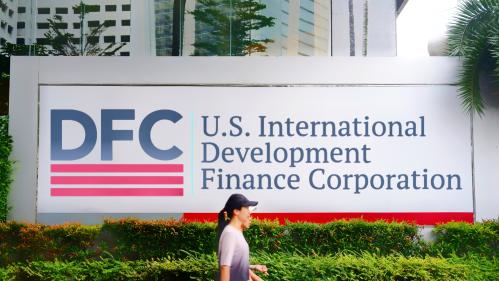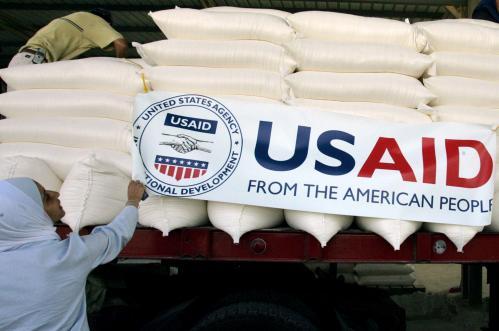

2:30 pm EST - 4:30 pm EST
Past Event
In the wake of post-tsunami humanitarian relief efforts, many observers are examining the way governments organize themselves to manage their foreign aid. The organization of U.S. foreign aid, in particular, is often criticized for being fragmented, and a number of the processes by which U.S. aid is implemented have long been recognized as cumbersome and even inappropriate to its tasks.
A Brookings workshop delved into these issues in depth and addressed the following questions:
What is the reality of the way the U.S. organizes itself to manage its expanding foreign aid program?
How does the U.S. compare with the way other aid-giving governments organize themselves?
What are the problems with U.S. foreign aid organization — and what are potential recommendations for major changes?
How can we streamline the process of getting resources out to the field?
The “softer side” of foreign policy – in the form of strategic, humanitarian, and development aid to foreign governments – is increasingly vital to U.S. government actions. Yet the organizational landscape of foreign aid is hopelessly fragmented: there are two major aid agencies – USAID and the Millennium Challenge Account (MCA), three smaller aid agencies, and other aid programs or responsibilities in the Department of State, the Treasury, and almost every other cabinet-level agency. Further, policy-making decisions and program responsibilities are often located in different agencies.
This bureaucratic proliferation causes a legion of problems: waste through duplication of effort, high transaction costs in the interactions between agencies, and, most importantly, a lack of coordination, both internally within U.S. aid programs, and externally between U.S. aid-giving programs, its partners overseas, and its recipients in foreign countries — who are baffled by the seeming lack of policy leadership.
There has been a long history of attempts at structural reforms. These include a 1980s effort to combine USAID, Department of State programs, and ACIA, and several bilateral commissions in the 1990s which tried to increase cooperation. A recent initiative bypassed current structural concerns altogether by creating a separate agency, the Millennium Challenge Account, to provide grants to promising countries in Africa.
None of these attempts at reform fully achieved their goals, in part because of the extraordinarily difficult political and public environment. Unlike aid programs in most other developed countries, foreign assistance in the U.S. suffers from a closely engaged and remarkably skeptical Congress, and an utterly ill-informed and similarly skeptical public. The high level of legislative engagement not only mires any attempt to create change, it may actually reduce accountability in USAID and other aid programs, since the measures allowable to arrive at their ambitious results are constrained by politics. Meanwhile, a public that bases its opinion of foreign assistance on TV portrayals of constant disasters in exotic countries and feckless U.S. attempts to help, both grossly overestimates the amount of foreign aid in the budget, and underestimates the effectiveness of the aid we give.
Yet as our high-level debate over changing foreign assistance continues (so far fruitlessly), the world also continues changing: our partners change the way they give aid, our own aid programs undergo internal evolution, and the global context for development has changed.
There are useful procedural lessons to learn from other Western aid-giving countries, although many of them benefit from a parliamentary system that produces a less acrimonious atmosphere surrounding debates over aid-giving form and function. Britain, for example, successfully overhauled and consolidated its aid-giving programs in the 1990s, creating the widely-acclaimed DFID. The emphasis other countries place on public education is even more instructive. The Danes, for example, spend ten times what we do on “development education,” explaining its methods and justifying its need – despite a much lower budget. And the Japanese incorporate information about global need and development aid into their educational curricula. At the very least, to build public support, the U.S. development community should support student exchanges and foreign language training, build a competitive grants program, and practice more community outreach.
In the absence of high-level reorganization, USAID (the largest and oldest U.S. aid-giving program), has been undergoing an internal evolution of its own. Today, there are fewer technical staff and smaller field offices; USAID accomplishes much of its work by increased outsourcing of larger contracts and grants, creating a “wholesaler of wholesalers” system. It has also developed more elaborate control-oriented planning and results-measurement systems. A critical analysis of these bureaucratic changes is essential to further our most important objective, getting resources out to the field.
And the global landscape of foreign aid continues to change. Instead of the once-simple world of governments interacting with other governments, these days, many agents are giving to many different kinds of recipients. The relevant players on the global aid landscape include corporate and public foundations, venture philanthropists, NGOs, high-net-worth individuals like Gates and Soros, social entrepreneurs in developing countries, immigrants sending remittances home, and more.
In the future, we must be able to work effectively with multiple groups, address diverse needs, and serve a variety of purposes with our foreign policy. A coherent plan for future US foreign assistance must reflect these multi-leveled global changes, not only in the bureaucratic framework surrounding the way we give aid, but the organizational design of those aid-giving programs, whatever outward shape they may take.
To address structure first: we believe that the best choice is to unify all aid programs into a single aid agency with unambiguous leadership. The second best option is to unify all major aid agencies — at the least, USAID and the MCA. Of course, other agencies will still want to have their own aid programs. MCA has yet to make its first disbursement, and remains extremely vulnerable to political whims in times of budget cutting. There is no sense in having two major aid-giving agencies.
The best location for this new aid agency would be a single cabinet level aid agency, or at least an agency with cabinet-level coordination. The next best choice is to combine USAID and the MCA and put them into the State Department.
Judging only by the present size of U.S. aid programs, a cabinet-level agency is not necessary, but this is an area we expect to grow massively in strategic importance. Many of the most pressing global issues happen within countries in the developing world. It makes sense to recognize the function we’ll be performing there and its critical importance. A advocate’s voice for aid below the cabinet level will not be reliably presented, and a cabinet level agency is better placed to educate the public. Diplomatic programs, of course, which are not aid-centered, can be kept in the State Department.
Whatever the location and specifics of the U.S.’s new approach to foreign assistance, its organizational design will have to encompass an ability for greater flexibility in responding to global events, a stronger and more appropriate evaluation process, greater emphasis on recipient responsibility, a new approach to contracting and reporting, a new relationship between the field and the headquarters, and a better relationship with legislators.
The relationship between policy makers and policy implementers is one of the most trenchant issues to consider here. As mentioned previously, USAID has been reducing its technical staff and field offices, and outsourcing more and more large contracts and grants, whose successes are evaluated by an elaborate results-measurement systems. These changes are troubling; outsourcing creates a disconnect between policy-making and implementation; former development workers reminisce that their interactions with the military were much smoother than with policy makers, since military officials “understand what it means to have men on the ground.” Further, development is essentially an experimental job, which may not be suitable to a pure “results-oriented” monitoring system. (As the old maxim goes, “You get what you measure”). Many of these system changes hinder workers in the field from doing their critical jobs.
At the same time, many USAID observers feel that this policy/implementation disconnect leads field staff to have an inflated notion of their own power and autonomy, since policy-makers are so far away, and field staff can control what information those policy-makers receive. Yet it is inappropriate for every aid program to set its own strategy, especially by default.
Although development aid in the U.S. clearly needs scrutiny of both its form and function, it is unclear which issue is the chicken, and which, egg. It is possible that widespread agreement on the exact purpose of U.S. foreign aid, and an inspiring long-term mission, could make the necessary bureaucratic structure obvious — whether a single cabinet level aid agency, or multiple dispersed programs. But it’s also true that debates on strategic mission are inevitably incoherent without the leadership provided by a clean bureaucracy. Although strong leaders — such as Henry Owen in the Carter administration — have been able to successfully pull people together to advocate for issues regardless of the institutional boundaries they have to transcend, it would be foolish to rely on the deus ex machina of such a charismatic figure suddenly emerging. Finding the most useful lever for change should be an urgent mission for the U.S. development community in the months and years ahead.

George Ingram
December 6, 2023

George Ingram
December 7, 2022

Patrick Fine
December 1, 2022